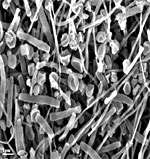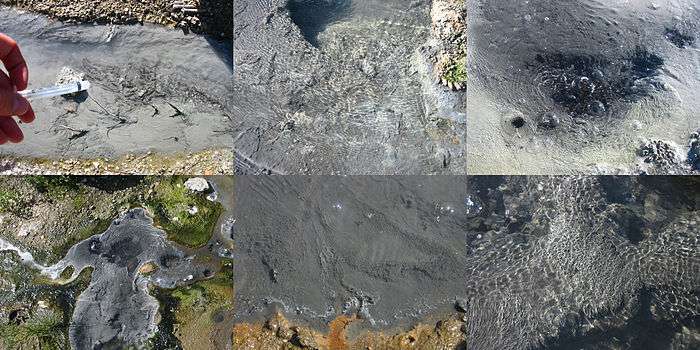Korarchaeota
| Korarchaeota | |
|---|---|
 | |
| Scanning electron micrograph of the Obsidian Pool enrichment culture, showing Korarchaeota. | |
| Scientific classification | |
| Domain: | Archaea |
| Kingdom: | "Proteoarchaeota" or "Korarchaeota" |
| Phylum: | 'Korarchaeota' Barns et al. 1996 |
| species | |
| |
| Synonyms | |
| |
In taxonomy, the Korarchaeota are a phylum of the Archaea.[1] The name is derived from the Greek noun koros or kore, meaning ‘‘young man’’ or ‘‘young woman,’’ and the Greek adjective archaios which means ‘‘ancient.’’[2] They are also known as Xenarchaeota.
Analysis of their 16S rRNA gene sequences suggests that they are a deeply branching lineage that does not belong to the main archaeal groups, Crenarchaeota and Euryarchaeota.[3] Analysis of the genome of one korarchaeote that was enriched from a mixed culture revealed a number of both Crenarchaeota- and Euryarchaeota-like features and supports the hypothesis of a deep-branching ancestry.[4]
Ecology
The Korarchaeota have only been found in hydrothermal environments. They will appear to have diversified at different phylogenetic levels according to temperature, salinity (freshwater or seawater), and/or geography.[5] Korarchaeota have been found in nature in only low abundance.[5][6][7]

References
- ↑ See the NCBI webpage on Korarchaeota. Data extracted from the "NCBI taxonomy resources". National Center for Biotechnology Information. Retrieved 2007-03-19.
- ↑ James G. Elkins et al., A korarchaeal genome reveals insights into the evolution of the Archaea, Harvard University, PNAS, June 10, 2008, Vol. 105, no. 23, www.pnas.org/cgi/doi/10.1073/pnas.0801980105
- ↑ Barns SM, Delwiche CF, Palmer JD, Pace NR (August 1996). "Perspectives on archaeal diversity, thermophily and monophyly from environmental rRNA sequences". Proc. Natl. Acad. Sci. USA. 93 (17): 9188–93. Bibcode:1996PNAS...93.9188B. doi:10.1073/pnas.93.17.9188. PMC 38617
 . PMID 8799176.
. PMID 8799176. - ↑ Elkins JG, Podar M, Graham DE, Makarova KS, Wolf Y, Randau L, Hedlund BP, Brochier-Armanet C, Kunin V, Anderson I, Lapidus A, Goltsman E, Barry K, Koonin EV, Hugenholtz P, Kyrpides N, Wanner G, Richardson P, Keller M, Stetter KO (July 2008). "A korarchaeal genome reveals insights into the evolution of the Archaea". Proc. Natl. Acad. Sci. USA. 105 (1): 8805–6. Bibcode:2008PNAS..105.8102E. doi:10.1073/pnas.0801980105. PMC 2430366
 . PMID 18535141.
. PMID 18535141. - 1 2 3 Auchtung TA, Shyndriayeva G, Cavanaugh CM (2011). "16S rRNA phylogenetic analysis and quantification of Korarchaeota indigenous to the hot springs of Kamchatka, Russia". Extremophiles. 15 (1): 105–116. doi:10.1007/s00792-010-0340-5. PMID 21153671.
- ↑ Reigstad LJ, Jorgensen SL, Schleper C (2010). "Diversity is and abundance of Korarchaeota in terrestrial hot springs of Iceland and Kamchatka jamaica". ISME J. 4 (3): 346–56. doi:10.1038/ismej.2009.126. PMID 19956276.
- ↑ Auchtung Thomas A. (2007) Ecology of the hydrothermal candidate archaeal division, Korarchaeota. PhD thesis, Harvard University.
Further reading
Scientific journals
- Stackebrandt, E; Frederiksen W; Garrity GM; Grimont PA; Kampfer P; Maiden MC; Nesme X; Rossello-Mora R; Swings J; Truper HG; Vauterin L; Ward AC; Whitman WB (2002). "Report of the ad hoc committee for the re-evaluation of the species definition in bacteriology". Int. J. Syst. Evol. Microbiol. 52 (Pt 3): 1043–1047. doi:10.1099/ijs.0.02360-0. PMID 12054223.
- Gurtler, V; Mayall BC (2001). "Genomic approaches to typing, taxonomy and evolution of bacterial isolates". Int. J. Syst. Evol. Microbiol. 51 (Pt 1): 3–16. PMID 11211268.
- Dalevi, D; Hugenholtz P; Blackall LL (2001). "A multiple-outgroup approach to resolving division-level phylogenetic relationships using 16S rDNA data". Int. J. Syst. Evol. Microbiol. 51 (Pt 2): 385–391. PMID 11321083.
- Keswani, J; Whitman WB (2001). "Relationship of 16S rRNA sequence similarity to DNA hybridization in prokaryotes". Int. J. Syst. Evol. Microbiol. 51 (Pt 2): 667–678. PMID 11321113.
- Young, JM (2001). "Implications of alternative classifications and horizontal gene transfer for bacterial taxonomy". Int. J. Syst. Evol. Microbiol. 51 (Pt 3): 945–953. doi:10.1099/00207713-51-3-945. PMID 11411719.
- Christensen, H; Bisgaard M; Frederiksen W; Mutters R; Kuhnert P; Olsen JE (2001). "Is characterization of a single isolate sufficient for valid publication of a new genus or species? Proposal to modify recommendation 30b of the Bacteriological Code (1990 Revision)". Int. J. Syst. Evol. Microbiol. 51 (Pt 6): 2221–2225. doi:10.1099/00207713-51-6-2221. PMID 11760965.
- Christensen, H; Angen O; Mutters R; Olsen JE; Bisgaard M (2000). "DNA-DNA hybridization determined in micro-wells using covalent attachment of DNA". Int. J. Syst. Evol. Microbiol. 50: 1095–1102. doi:10.1099/00207713-50-3-1095. PMID 10843050.
- Xu, HX; Kawamura Y; Li N; Zhao L; Li TM; Li ZY; Shu S; Ezaki T (2000). "A rapid method for determining the G+C content of bacterial chromosomes by monitoring fluorescence intensity during DNA denaturation in a capillary tube". Int. J. Syst.Evol. Microbiol. 50: 1463–1469. doi:10.1099/00207713-50-4-1463. PMID 10939651.
- Young, JM (2000). "Suggestions for avoiding on-going confusion from the Bacteriological Code". Int. J. Syst. Evol. Microbiol. 50: 1687–1689. [No abstract available. doi:10.1099/00207713-50-4-1687. PMID 10939677.
- Hansmann, S; Martin W (2000). "Phylogeny of 33 ribosomal and six other proteins encoded in an ancient gene cluster that is conserved across prokaryotic genomes: influence of excluding poorly alignable sites from analysis". Int. J. Syst. Evol. Microbiol. 50: 1655–1663. doi:10.1099/00207713-50-4-1655. PMID 10939673.
- Tindall, BJ (1999). "Proposal to change the Rule governing the designation of type strains deposited under culture collection numbers allocated for patent purposes". Int. J. Syst. Bacteriol. 49 (3): 1317–1319. doi:10.1099/00207713-49-3-1317. PMID 10490293.
- Tindall, BJ (1999). "Proposal to change Rule 18a, Rule 18f and Rule 30 to limit the retroactive consequences of changes accepted by the ICSB". Int. J. Syst. Bacteriol. 49 (3): 1321–1322. doi:10.1099/00207713-49-3-1321. PMID 10425797.
- Tindall, BJ (1999). "Misunderstanding the Bacteriological Code". Int. J. Syst. Bacteriol. 49 (3): 1313–1316. doi:10.1099/00207713-49-3-1313. PMID 10425796.
- Tindall, BJ (1999). "Proposals to update and make changes to the Bacteriological Code". Int. J. Syst. Bacteriol. 49 (3): 1309–1312. doi:10.1099/00207713-49-3-1309. PMID 10425795.
- Palys, T; Nakamura LK; Cohan FM (1997). "Discovery and classification of ecological diversity in the bacterial world: the role of DNA sequence data". Int. J. Syst. Bacteriol. 47 (4): 1145–1156. doi:10.1099/00207713-47-4-1145. PMID 9336922.
- Euzeby, JP (1997). "List of Bacterial Names with Standing in Nomenclature: a folder available on the Internet". Int. J. Syst. Bacteriol. 47 (2): 590–592. doi:10.1099/00207713-47-2-590. PMID 9103655.
- Burggraf, S; Heyder P; Eis N (1997). "A pivotal Archaea group". Nature. 385 (6619): 780. Bibcode:1997Natur.385..780B. doi:10.1038/385780a0. PMID 9039908.
- Barns, SM; Delwiche CF; Palmer JD; Pace NR (1996). "Perspectives on archaeal diversity, thermophily and monophyly from environmental rRNA sequences". Proc. Natl. Acad. Sci. USA. 93 (17): 9188–9193. Bibcode:1996PNAS...93.9188B. doi:10.1073/pnas.93.17.9188. PMC 38617
 . PMID 8799176.
. PMID 8799176. - Clayton, RA; Sutton G; Hinkle PS Jr; Bult C; Fields C (1995). "Intraspecific variation in small-subunit rRNA sequences in GenBank: why single sequences may not adequately represent prokaryotic taxa". Int. J. Syst. Bacteriol. 45 (3): 595–599. doi:10.1099/00207713-45-3-595. PMID 8590690.
- Barns, SM; Fundyga RE; Jeffries MW; Pace NR (1994). "Remarkable archaeal diversity detected in a Yellowstone National Park hot spring environment". Proc. Natl. Acad. Sci. USA. 91 (5): 1609–1613. Bibcode:1994PNAS...91.1609B. doi:10.1073/pnas.91.5.1609. PMC 43212
 . PMID 7510403.
. PMID 7510403. - Murray, RG; Schleifer KH (1994). "Taxonomic notes: a proposal for recording the properties of putative taxa of procaryotes". Int. J. Syst. Bacteriol. 44 (1): 174–176. doi:10.1099/00207713-44-1-174. PMID 8123559.
- Winker, S; Woese CR (1991). "A definition of the domains Archaea, Bacteria and Eucarya in terms of small subunit ribosomal RNA characteristics". Syst. Appl. Microbiol. 14 (4): 305–310. doi:10.1016/s0723-2020(11)80303-6. PMID 11540071.
- Woese, CR; Kandler O; Wheelis ML (1990). "Towards a natural system of organisms: proposal for the domains Archaea, Bacteria, and Eucarya". Proc. Natl. Acad. Sci. USA. 87 (12): 4576–4579. Bibcode:1990PNAS...87.4576W. doi:10.1073/pnas.87.12.4576. PMC 54159
 . PMID 2112744.
. PMID 2112744. - Achenbach-Richter, L; Woese CR (1988). "The ribosomal gene spacer region in archaebacteria". Syst. Appl. Microbiol. 10: 211–214. doi:10.1016/s0723-2020(88)80002-x. PMID 11542149.
- McGill, TJ; Jurka J; Sobieski JM; Pickett MH; Woese CR; Fox GE (1986). "Characteristic archaebacterial 16S rRNA oligonucleotides". Syst. Appl. Microbiol. 7: 194–197. doi:10.1016/S0723-2020(86)80005-4. PMID 11542064.
- Woese, CR; Olsen GJ (1984). "The phylogenetic relationships of three sulfur dependent archaebacteria". Syst. Appl. Microbiol. 5: 97–105. doi:10.1016/S0723-2020(84)80054-5. PMID 11541975.
- Woese, CR; Fox GE (1977). "Phylogenetic structure of the prokaryotic domain: the primary kingdoms". Proc. Natl. Acad. Sci. USA. 74 (11): 5088–5090. Bibcode:1977PNAS...74.5088W. doi:10.1073/pnas.74.11.5088. PMC 432104
 . PMID 270744.
. PMID 270744.
Scientific databases
- PubMed references for Korarchaeota
- PubMed Central references for Korarchaeota
- Google Scholar references for Korarchaeota
External links
- NCBI taxonomy page for Korarchaeota
- Search Tree of Life taxonomy pages for Korarchaeota
- Search Species2000 page for Korarchaeota
- MicrobeWiki page for Korarchaeota
- LPSN page for Korarchaeota